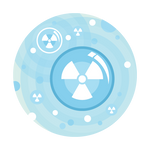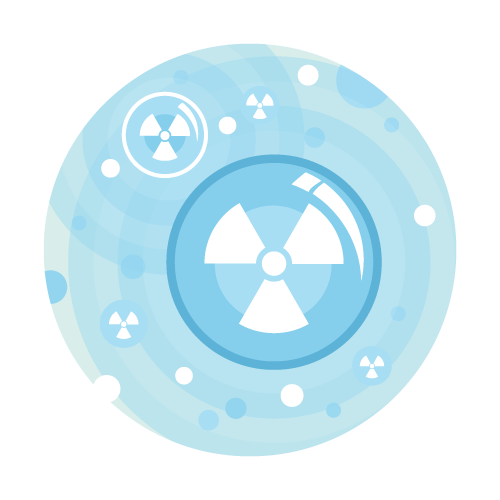
Radon Gas in Air and Water
Our blog is written by real experts— not AI. Each guide is carefully reviewed and updated based on the latest research. Plus, with no affiliate links, you can count on unbiased insights you can trust.
You can’t see it. You can’t taste it. You can’t smell it. Radon gas is an imperceptible threat. But radon gas affects approximately one in every 15 homes in the United States at a level above which the EPA recommends corrective action.[1][2] A naturally occurring radioactive element, radon sneaks into homes and buildings and threatens people's health everyday.
Table of Contents:
- What Is Radon?
- How Can You Be Exposed to Radon?
- What Are the Health Impacts of Radon Gas?
- How Can You Protect Your Home from Radon?
What Is Radon Gas?
A naturally occurring radioactive element, radon is formed when uranium, thorium, or radium decays.[3] Radon forms from the natural breakdown of soil, rock, and water. It diffuses into the air you breathe. It is found all across the United States and generally exists in very low concentrations outdoors, meaning we likely breathe it everyday![5] Radon can also occur in water, but the biggest health risk is airborne radon.
As it decays, radon emits alpha, beta, and gamma radiation which is harmful to human health.[4]
For most people radon is the greatest environmental source of exposure to radiation.[6] It is readily volatile — meaning it evaporates into the air quickly. Subsequently, all routes of exposure (ingestion, inhalation, and dermal) are relevant if one is exposed to radon via drinking water. Elevated levels of radon in drinking water may lead to an increased risk of lung cancer.[7]
How Are You Exposed to Radon?
The most common means of exposure is through the air we breathe, because radon can enter through cracks in your homes (in floors, walls, foundations etc.,) or accumulate in contaminated building materials.[7] It can also be found in well water: radon gas can also dissolve and accumulate underground water sources. When that water is then used for bathing, cooking, or cleaning, radon gas can then escape from the water and volatilize into the air.
Note: Some radon does also remain in the water.
Water that comes from surface water sources (reservoirs, lakes, etc.,) is not typically at risk for radon contamination as radon dissipates into the air before it makes its way to your tap.
Homes that are well insulated, tightly sealed, or built on contaminated soil are most frequently at risk for radon contamination.
How Is Radon Measured?
Radioactivity is typically measured in Curies (Ci) after the French physicist Marie Curie, who was a prominent leader in radioactive element research. One Curie is equivalent to the amount of radiation given off by one gram of radium, and one picoCurie (pCi) represents the decay of about two radioactive particles per minute.
The average outdoor concentration of radon in air is around 0.4 piC/L (picoCuries per liter).[8] Serious concern arises when indoor air radon levels are elevated above the average of 1.3 pCi/L–but the level at which EPA recommends you take corrective action is above 4 piC/L.
What Are the Health Impacts of Radon?
Airborne radon itself is not hazardous. However, the products of radon decay, which is inevitable, are a different story.[9]
The largest health concern regarding radon exposure is lung cancer. In fact, it is the number one cause of lung cancer amongst non-smokers.[10] Radon is responsible for 21,000 lung cancers deaths annually, and 2,900 of these deaths occur among people who have never smoked.[10] If you are a smoker, your risk of radon-related lung cancer is substantially higher.[11]
During decay, radon emits radioactive particles. When these particles are inhaled over a long time period, they damage the cells that line the lungs. Along with an increased risk of lung cancer, radon has been associated with genotoxicity based on evidence from epidemiological, occupational, and animal studies.[12]
How Can You Test Your Home for Radon?
Due to its imperceptible nature, testing is the only sure fire way to know if you are at risk for radon exposure. The EPA estimates that 8 million, or 1 in every 15 homes, have elevated radon levels.[8] Because radon is colorless, odorless, and tasteless, it is very important to test for it regardless of whether you suspect you have a problem.
Air Testing for Radon
You should test your home’s airborne radon levels:[13]
-
If it’s never been tested or radon levels are unknown
-
If you are preparing to buy or sell the property
-
Before and after any renovations
-
If you are located in an area with known levels of elevated radon concentrations
There are two types of tests for radon in air:[14]
-
Short-term air testing: Short term tests usually take about 2-7 days. You simply place a test kit on the lowest level of your home and leave it in a place where it will be undisturbed. Then, send the results back to a lab.
- Long-term air testing: Long term tests take at least 3 months. They also need to be placed on the lowest used level of your home and left untouched. Long term tests are usually more accurate because they collect more data and measure long term averages of radon levels.
If you detect radon levels about 4 picoCuries per liter (pCi/L) of air, you should take action.
If you spend lots of time indoors in a home with elevated levels of radon, you are putting yourself at a higher risk. Also, if you burn wood or coal in a home that has high radon levels, the combination of additional particles in the air with radon can increase your chance of lung cancer.
Water Testing for Radon:
While exposure to radon in air is a much more serious problem than radon in water, elevated levels in water may suggest an air problem.
You should test your home’s water radon levels:[13]
-
If you are served by a groundwater source (private or shared well)
-
If the air in your home has a known radon problem
Radon Water Test
Test your drinking water for radon with high precision.
How Can You Reduce Radon in Air and Water?
Removing Radon from Air:
If, after testing, you’ve found that there is elevated radon in the air in your home, you should consider contacting a licensed profession to install a radon mitigation system.[15]
Other steps you can take to reduce the risk and impacts of radon exposure include:
-
Open windows and use fans to circulate air and increase airflow (Note: this is a temporary strategy only and high radon levels in air should be addressed with a long term solution).
-
Seal cracks in floors and walls to prevent radon-contaminated air from making its way into your home. Testing for radon afterwards is recommended as well to ensure radon levels have been lowered.
-
Lay a gas-permeable gravel layer with plastic sheeting and a vent pipe: Gas is released from the soil and moves easily through the gravel. The plastic cover prevents gas from traveling into the home, and the gas is instead diverted to a vent pipe which runs up to roof to safely release the gas outdoors.
-
Quit smoking. Smoking significantly increases the risk of lung cancer from radon exposure.
Removing Radon from Water:
For high levels of radon in water, aeration or air stripping systems are most effective. Aeration works by pumping air into water. Volatile compounds (such as radon) are then pulled into the air and removed from the water. These systems are typically installed at the point-of-entry and can be large (the size of a small refrigerator) and expensive–so having test results to verify the amount of radon in your water is strongly recommended.
Read More
▾Sources and References
▾- Surgeon General Releases National Health Advisory On Radon
- Radon | US EPA
- Radon and Your Health
- What Is Ionizing Radiation?
- A Citizen's Guide to Radon (EPA)
- Radionuclide Basics: Radon | US EPA
- Radon and Cancer - NCI
- Home Buyer's and Seller's Guide to Radon
- Radon's Progeny Decay | Harvard Natural Sciences Lecture Demonstrations
- Health Risk of Radon | US EPA
- Surgeon General Releases National Health Advisory On Radon
- A comparative study of genotoxicity endpoints for women exposed to different levels of indoor radon concentrations
- Test Your Home | CDC
- Radon | American Lung Association
- Reduce Radon Levels in Your Home | NCEH | CDC











